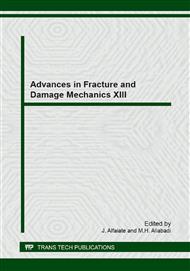p.445
p.449
p.453
p.457
p.461
p.465
p.469
p.473
p.477
Numerical Analysis about the Strength of Jointed Rock under Hydrodynamic Pressure
Abstract:
The generalized model is constructed for jointed rock mass under hydrodynamic pressure. Meanwhile, the influences of crack angle, under hydrodynamic pressure, on the compressive strength is researched. The results show that the flow rate has a significant influence on the compressive strength of jointed rock. When the angle of the crack is 30°, the higher the hydrodynamic pressure is, the larger the decrease of the compressive strength is. While the slopes of the crack are 45° and 60°, the larger the hydrodynamic pressure is, the bigger the increase of the compressive strength is. In the meantime, under the same flow rate, the compressive strength of jointed rock transform regularly with crack angle changed. And the compressive strength of the jointed rock with 45° crack is largest, while the jointed rock with 30° crack is lowest.
Info:
Periodical:
Pages:
473-476
Citation:
Online since:
September 2014
Authors:
Price:
Сopyright:
© 2015 Trans Tech Publications Ltd. All Rights Reserved
Share:
Citation:


